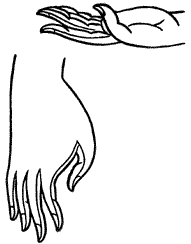
Touching the Earth (right hand) Meditation (left hand)
Mudrā
|
|
|
Touching the Earth (right hand) Meditation (left hand) |
The most important aspect of the iconography of the Buddha is gestures made with the hands, known as mudrā. These gestures have meanings which are known throughout the Buddhist world, and when combined with the postures described above, give a complete representation, usually associated with a particular incident in the life of the Buddha.
The six mudrā associated with the Buddha are:
1. Touching the earth (Bhūmisparsa mudrā): the right hand rests on the right thigh with the fingers pointing downwards and touching the earth (not always literally, as can be seen in the image at the top of this page). The left hand rests in the dhyāna mudrā position in the Buddha's lap. This mudrā is frequently called "calling the earth to witness," or by its more literal meaning, "Buddha subduing Māra" (the demon who tempted the Buddha by trying to seduce him with the vision of beautiful women). The gesture thus symbolizes the Buddha's renunciation of worldly desire, and since this is the central moral precept of Buddhism this is by far the most commonly depicted mudrā.
|
|
|
Meditation |
2. Meditation (Dhyāna mudrā): the hands are shown lying flat in the Buddha's lap, palms upward. This mudrā is usually associated with a seated Buddha. The nerve channel associated with the mind of enlightenment pass through the thumbs. It shows that the Buddha is disciplining his mind through mental concentration, a necessary step to achieving enlightenment. The joining of the thumbs is a gesture of an auspicious sign. The sign hand could also be represented in this meditation gesture, in combination with another gesture.
|
|
|
Charity (right hand) |
3. Charity (Varana mudrā): the right arm is shown pendent (extended downwards), with the open palm turned to the front and the fingers extended. This 'mudrā is usually associated with a standing Buddha. This position can signify either that the Buddha is granting or receiving charitable offerings.
4. Absence of fear (Abhāya mudrā): either one or both arms are shown bent at the elbow and the wrist, with the palm facing outwards and the fingers pointing upwards. It shows the Buddha either displaying fearlessness in the face of adversity, or enjoining others to do so. This 'mudrā is usually associated with a standing Buddha, but seated representations are not uncommon.
|
|
|
Reasoning (right hand) |
5. Reasoning and exposition (Vitarka mudrā): the arm and hand are positioned in the same manner as in the abhāya mudrā, except that the thumb and forefinger are brought together. The gesture can be made with either the right or left hand (usually the right), but not both. This mudra signifies an appeal to reason, or the giving of instruction. When the thumb and index finger are brought together, it is a symbol of wisdom. The three fingers represent the Three Jewels of the Dharma, Sangha and Buddha. Since the Buddha is appealing to reason, the gesture is often interpreted as an appeal for peace.
6. Setting the wheel in motion (Dharmachakrā mudrā): the hands are held in front of the chest, with both hands in the vitarka mudrā position, with the fingers of the left hand resting in the palm of the right hand. This is a less common mudrā since it refers to a particular episode in the Buddha's life: his first sermon, when he "set the wheel (of his life's work) in motion." It can be used for both seated and standing images.
sources: http://en.wikipedia.org/wiki/Iconography_of_the_Buddha_%28Thailand_and_Laos%29